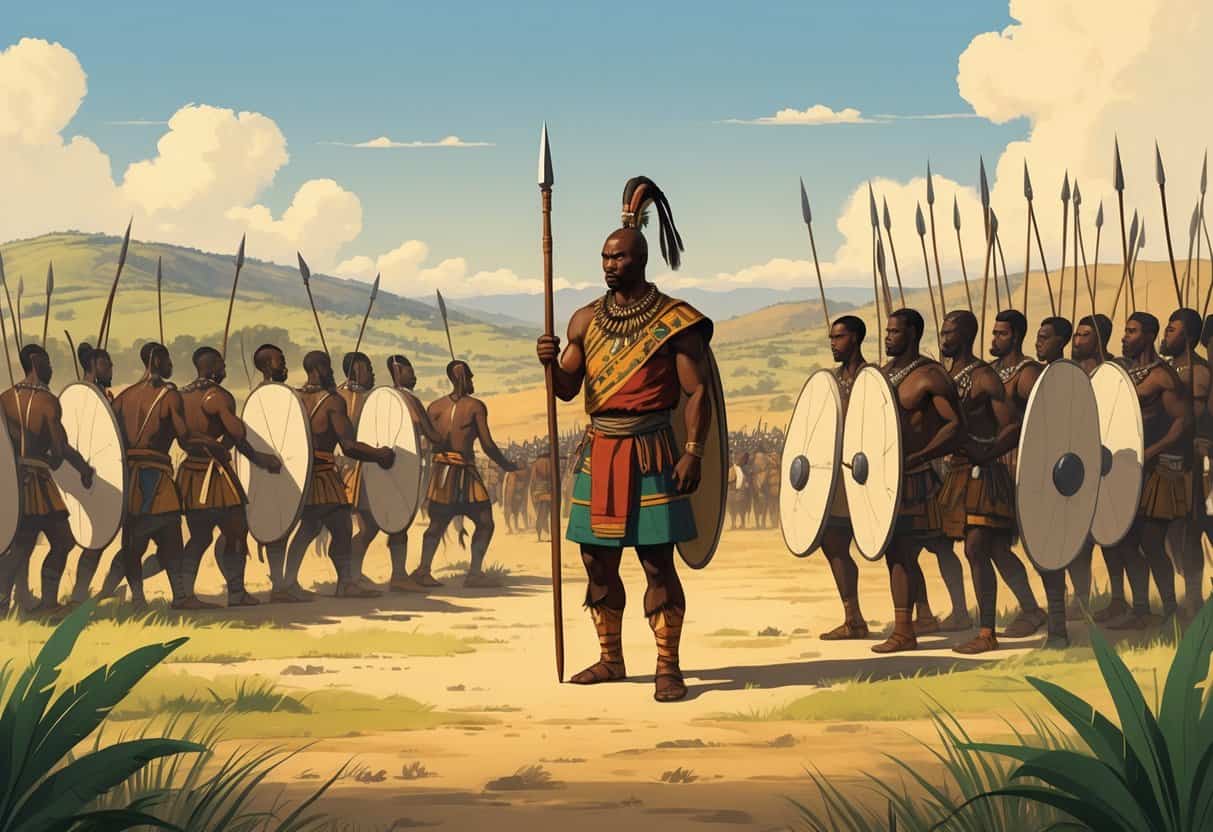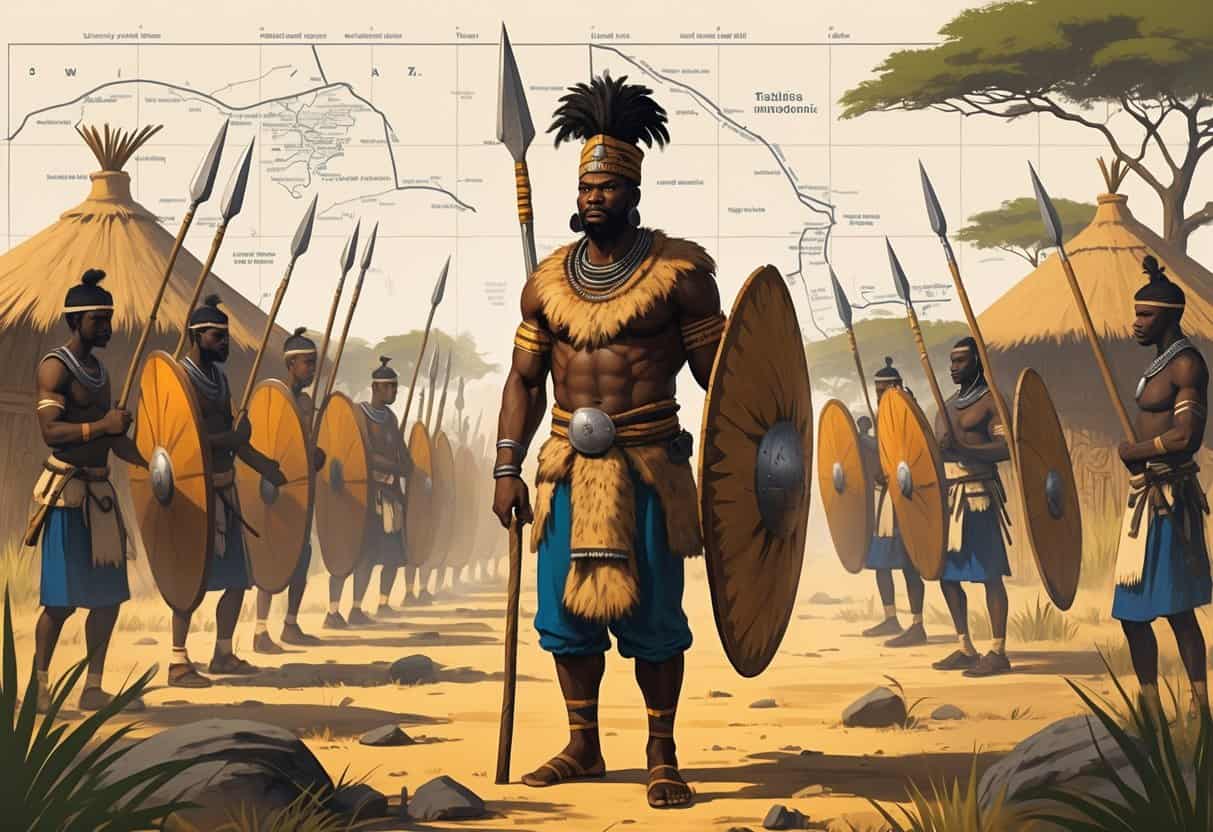Shaka Zulu changed the way wars were fought in Southern Africa by creating new military tactics and training methods.
His most important innovations included the introduction of the assegai, a short stabbing spear, and the “bullhorn” attack formation that allowed his army to surround enemies effectively.
These changes made the Zulu army faster, stronger, and more organized than before.

You’ll see how Shaka built a powerful army by focusing on both physical training and smarter battle strategies.
His military system transformed the Zulu Kingdom into a force feared by neighbors.
Understanding these innovations helps explain how Shaka shaped the history of Southern Africa.
Key Takeaways
- Shaka introduced new weapons and tactics that improved Zulu fighting skills.
- His methods made the Zulu army more disciplined and powerful.
- These changes affected the balance of power in Southern Africa.
Foundations of Shaka Zulu’s Military System

Understanding Shaka Zulu’s military system means looking at how he built his power from local clans and rival groups.
His rise depended on reshaping traditional leadership and using alliances and force to unite the Zulu people and surrounding areas.
Zulu Society and the Rise of Shaka
The Zulu started as a small clan within Natal, connected by close kinship ties.
Leadership came through hereditary chiefs, but during Shaka’s time, the chieftaincy was often contested.
Shaka, not the legitimate heir, used his skills and strength to gain control.
His rise challenged older family lines and traditions.
By winning loyalty from young warriors and reorganizing the clan system, he created a new power base.
Elders and chiefs played big roles.
Shaka had to balance respect for traditional rulers while centralizing power around himself.
This shift affected how the Zulu organized for war and peace.
Early Influences: Mthethwa and Ndwandwe
Before Shaka’s rise, there were two major groups in the region: the Mthethwa under Chief Dingiswayo and the Ndwandwe kingdom.
Dingiswayo mentored Shaka and helped him gather support.
The Mthethwa acted as a model for early state-building.
Dingiswayo gave Shaka military training and political support, which helped Shaka learn about governing a larger group and organizing armies.
Rivalry with the Ndwandwe pushed Shaka to innovate militarily.
Fighting powerful neighbors forced him to develop new tactics.
These challenges shaped how his army was trained and structured.
State-Building and Consolidation Strategies
After taking control of the Zulu clan, Shaka focused on building a wider state.
He absorbed smaller chiefdoms by defeating or allying with their leaders.
One key tactic was rewarding loyalty through patronage—giving land, cattle, or status to followers.
He created a clear hierarchy, making sure chiefs reported directly to him.
Shaka also redesigned military and social organization.
He grouped warriors by age and regiment, which improved discipline and loyalty.
This system allowed him to control distant areas and maintain order inside the growing Zulu state.
| Key Actions by Shaka | Purpose |
|---|---|
| Reorganized clans | Centralize authority |
| Used patronage | Secure loyalty of chiefs |
| Structured armies | Improve military strength |
| Absorbed rivals | Expand Zulu state |
Key Military Innovations and Tactics
Shaka Zulu changed how people thought about war by creating a strong military system built on strict organization, new weapons, tough training, and clever battle moves.
These changes helped the Zulu warriors win many wars of conquest.
Impi Structure and Regimental Organization
The Zulu army, called an impi, was organized into regiments by age groups known as amazi.
Each regiment had a leader, the induna, who kept order and guided warriors.
The structure was similar to a well-planned phalanx.
Warriors trained and lived together, building teamwork and loyalty.
This made the impis disciplined and ready to fight as a strong unit.
Regiments could work alone or join with others for larger battles.
This organization let the Zulu move large groups quickly and in order.
It made their military system effective in many wars, including the famous Zulu War.
Weapons: Assegai, Shield, and Headband
The main weapon was the assegai, a short stabbing spear for close combat.
This was different from older, longer spears used for throwing.
Zulus also used a large hide shield, which protected them while closing in on enemies.
The shield’s size and shape made it easier to use in the “bull horn” formation.
Warriors wore headbands decorated with feathers.
These showed rank and encouraged loyalty, and helped identify warriors during battles.
Training, Discipline, and Loyalty
Training started young.
It included running, mock battles, and learning to use weapons.
This gave warriors the strength and skill to fight well.
Shaka enforced strict discipline.
If warriors broke rules or showed cowardice, punishments were harsh.
Ceremonies like circumcision and other rites helped unite warriors.
Loyalty to the king and tribe was strengthened through these rituals and the shared hardships of training.
Tactical Innovations: The ‘Buffalo Horns’ Formation
Shaka came up with the “buffalo horns” formation.
It worked by surrounding the enemy like a bull’s horns.
This tactic used three parts:
- Chest: Main attack force to engage the enemy frontally.
- Horns: Flanking forces that encircle the enemy on both sides.
- Loins: Reserve forces held in the center to support and exploit weaknesses.
The formation let the Zulu trap enemies and attack from all sides.
Combined with fast, disciplined impis and close-combat weapons, this gave them a big advantage in battle.
Impact of Shaka’s Reforms on Southern Africa
Shaka’s military changes reshaped the power balance in southern Africa.
His new tactics helped form a strong Zulu state, affected local populations, and altered relations with neighbors and European settlers.
These shifts caused widespread movement and conflict among many tribes.
The Mfecane and Regional Upheaval
Shaka’s military innovations triggered the Mfecane, a period of chaos and migration across southern Africa.
As the Zulu expanded, they displaced many Nguni tribes, including the Xhosa and the Swazi.
This caused population pressure and unrest far beyond Zulu borders.
The movement of people led to the collapse or merging of smaller chiefdoms.
Some groups fled to areas like Zimbabwe and the Transkei.
Others joined or fought the Zulu.
The violence between expanding armies caused widespread disruption.
Expansion of the Zulu State
Shaka turned a small clan into the powerful Zulu Empire by uniting various northern Nguni groups.
His army’s new skills, like the short stabbing spear and buffalo horns formation, helped quickly defeat rivals.
The Zulu took control of land and resources, including key trading routes.
This consolidation increased their strength and wealth.
The empire’s rise drew in more people as chieftains and warriors joined Shaka.
Rivalries and External Relations
Shaka’s rise changed relations with neighbors and Europeans.
The Zulu fought battles against Cape Colony settlers and resisted white settlers and missionaries.
Their victory at Blood River cemented their reputation.
Trade became more complex as the Zulu controlled vital ivory routes.
Rival tribes, like the Swazi and Xhosa, had ongoing feuds with the Zulu.
The mix of war, trade, and diplomacy shaped southern Africa for decades.
Legacy, Myth, and Historical Debate
Shaka Zulu’s life is full of stories that blend fact and myth.
His death led to a major power struggle in the Zulu Kingdom.
His image changes depending on who’s telling the story, which definitely shapes how people see him now.
The effects of his leadership still echo in later events like the Anglo-Zulu War and the British invasion.
Assassination and the Succession Crisis
Shaka was assassinated in 1828, reportedly by his half-brothers Dingane and Mhlangana.
This happened after he grew mentally unstable following his mother Nandi’s death.
His violent rule and harsh policies caused unrest among the amakhosi (chiefs).
After Shaka’s death, Dingane took power but faced immediate challenges.
The kingdom was unstable from Shaka’s expansionist wars.
This created a messy succession crisis as different leaders struggled for control.
That period shaped the future of the Zulu Kingdom in a big way.
Shaka Zulu’s Image in History and Popular Culture
Shaka’s image has been shaped by both myth and history.
Early accounts, like those from Henry Francis Fynn, often exaggerated his cruelty.
Later historians, including Dan Wylie and Julian Cobbing, criticized these views, calling some stories the “myth of iron”—meaning a lot of tales were false or biased.
You’ll find Shaka portrayed as either a ruthless warlord or a brilliant leader who changed warfare with tactics like the “buffalo horns” formation.
This split view affects how his legacy gets understood.
Films, books, and media often mix legend with fact, which definitely influences popular views far from historical truth.
The Anglo-Zulu War and Long-Term Outcomes
The Anglo-Zulu War of 1879 happened long after Shaka’s death, yet the kingdom he created still shaped everything. The British, with people like Theophilus Shepstone leading the charge, wanted control over the region.
There were some early Zulu victories. Still, in the end, the British conquered the kingdom, and Zulu independence was lost.
Rhodes University and several other institutions have dug into how Shaka’s military ideas played into the conflict and even broader colonial history. The war changed South Africa’s politics in ways that still echo today, especially when you look at the region’s cultural memory and identity.
